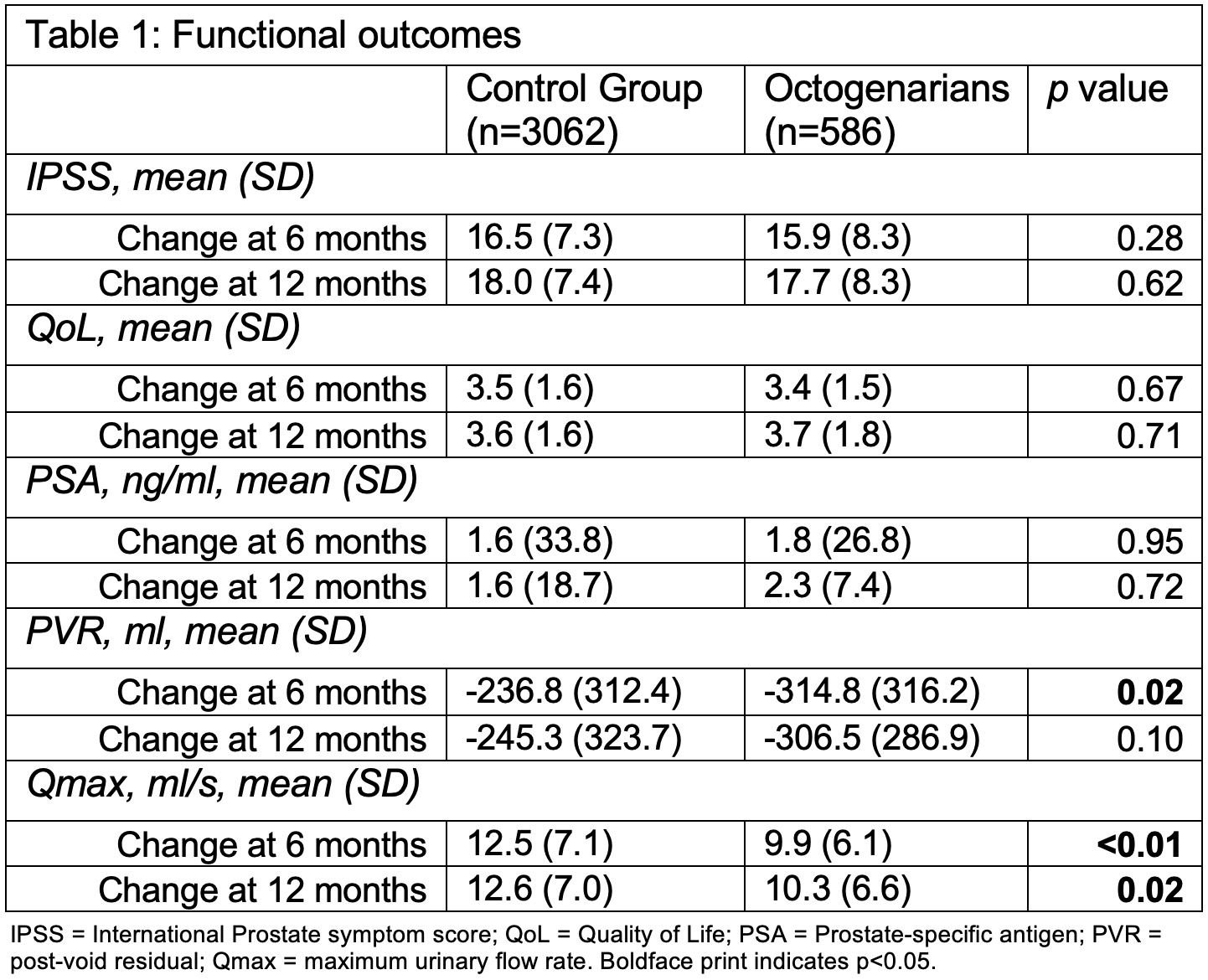Back
Introduction: GreenLight photoselective vaporization of the prostate (PVP) is a surgical treatment for benign prostatic hyperplasia (BPH) that yields comparable results to transurethral resection of the prostate while demonstrating lower postoperative bleeding rates. However, granular data is lacking for patients above the age of 80. Considering the aging patient population, there is a need to further characterize outcomes in elderly patients. The present study analyzes the largest international GreenLight database, the Global GreenLight Group (GGG), to evaluate the functional and safety profile of GreenLight PVP in octogenarians.
Methods: The GGG is a database comprised of patients that underwent GreenLight PVP from 2011 to 2019 performed by 8 experienced high-volume urologists at 7 different international hospitals. Patients 80 years or older at the time of surgery were categorized as octogenarians. They were compared to a similar group of patients undergoing PVP below the age of 80.
Results: Among 3,648 patients, 586 (16%) men were above the age of 80. Compared to patients under the age of 80, octogenarians had larger prostates (76.0ml vs 71.9ml, p=0.02) and a lower BMI (25.6 vs 26.7, p=0.045). They also had higher ASA scores: 61.0% were considered high-medical-risk compared to 22.7% in those under the age of 80. Operative time was not significantly longer in octogenarians compared to the control group. The improvement in functional outcomes between 80-year-old patients and control patients was not significantly different at one-year follow-up, with the exception of maximum urinary flow (Qmax) that favoured younger patients. The changes in functional outcomes between octogenarians and control patients can be found in Table 1. The odds of transfusion were greater for older patients [OR 8.2 (95% CI 3.6–18.9, p<0.01)], but they were not at increased risk of hematuria. Moreover, octogenarians had higher hospital readmission rates (23.0% vs 11.9%, p<0.01).
Conclusions: GreenLight PVP is an effective surgical option for treating symptomatic BPH in octogenarians and achieves similar functional outcomes compared to younger patients. The odds of transfusion were higher in patients over 80, but the absolute risk remains low. The 30-day hospital readmission rate however was higher in octogenarians. SOURCE OF
Funding: None.

Moderated Poster Session
Session: MP51: Benign Prostatic Hyperplasia: Surgical Therapy & New Technology II
MP51-06: Safety and Efficacy of GreenLight PVP in Octogenarians: Evaluation of the Global GreenLight Group Database
Sunday, April 30, 2023
7:00 AM – 9:00 AM CST
Location: S404C

Kevin C. Zorn, MD
University of Montreal
Poster Presenter(s)
Introduction: GreenLight photoselective vaporization of the prostate (PVP) is a surgical treatment for benign prostatic hyperplasia (BPH) that yields comparable results to transurethral resection of the prostate while demonstrating lower postoperative bleeding rates. However, granular data is lacking for patients above the age of 80. Considering the aging patient population, there is a need to further characterize outcomes in elderly patients. The present study analyzes the largest international GreenLight database, the Global GreenLight Group (GGG), to evaluate the functional and safety profile of GreenLight PVP in octogenarians.
Methods: The GGG is a database comprised of patients that underwent GreenLight PVP from 2011 to 2019 performed by 8 experienced high-volume urologists at 7 different international hospitals. Patients 80 years or older at the time of surgery were categorized as octogenarians. They were compared to a similar group of patients undergoing PVP below the age of 80.
Results: Among 3,648 patients, 586 (16%) men were above the age of 80. Compared to patients under the age of 80, octogenarians had larger prostates (76.0ml vs 71.9ml, p=0.02) and a lower BMI (25.6 vs 26.7, p=0.045). They also had higher ASA scores: 61.0% were considered high-medical-risk compared to 22.7% in those under the age of 80. Operative time was not significantly longer in octogenarians compared to the control group. The improvement in functional outcomes between 80-year-old patients and control patients was not significantly different at one-year follow-up, with the exception of maximum urinary flow (Qmax) that favoured younger patients. The changes in functional outcomes between octogenarians and control patients can be found in Table 1. The odds of transfusion were greater for older patients [OR 8.2 (95% CI 3.6–18.9, p<0.01)], but they were not at increased risk of hematuria. Moreover, octogenarians had higher hospital readmission rates (23.0% vs 11.9%, p<0.01).
Conclusions: GreenLight PVP is an effective surgical option for treating symptomatic BPH in octogenarians and achieves similar functional outcomes compared to younger patients. The odds of transfusion were higher in patients over 80, but the absolute risk remains low. The 30-day hospital readmission rate however was higher in octogenarians. SOURCE OF
Funding: None.

